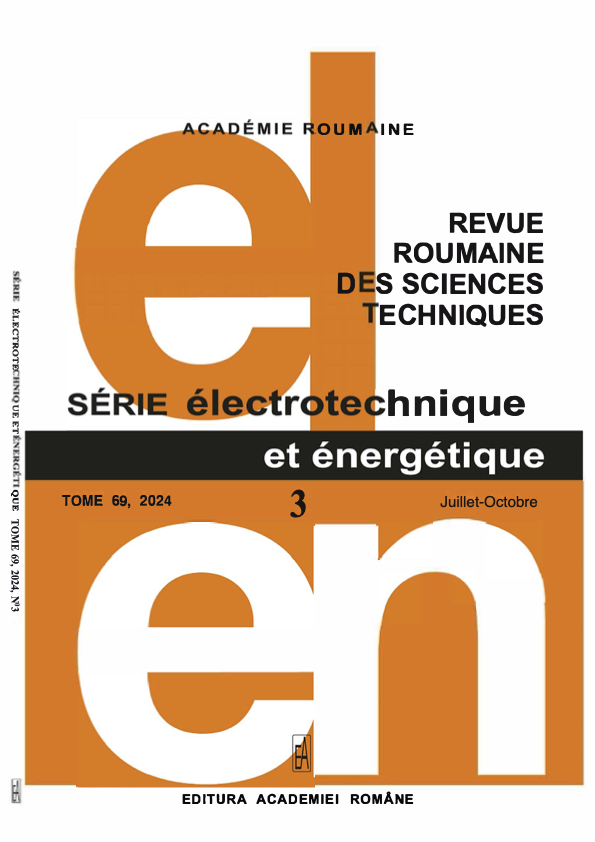PARALLEL PLATFORM CONTROLLER BASED ON ADAPTIVE DIFFERENCE ALGORITHM – PART 2
DOI:
https://doi.org/10.59277/RRST-EE.2024.69.3.14Keywords:
Workspace control, Model predictive controller (MPC), Adaptive difference algorithm, Parallel platform controlAbstract
There are two main approaches to motion control on parallel platforms: joint space control and workspace control. Joint space control is an easy-to-implement semi-closed-loop strategy, but its control effect could be better. The workspace control is to obtain the real-time position of the parallel platform through the forward solution and close the speed and position loop of the parallel platform in the workspace. This paper uses a Model Predictive Controller (MPC) to control the parallel platform with workspace control as the research goal. The loss function is constructed based on the swarm intelligence optimization idea, and the adaptive difference algorithm is used to optimize the parameters of MPC. This part uses MATLAB to perform simulation experiments to complete the S-shaped velocity trajectory planning algorithm. In addition, the control effect of MPC and position-loop PI controller in a robust disturbance environment is compared. Experiments show that MPC has the advantages of low energy consumption and high control accuracy.
References
(1) J. Ma, H. Li, Research on rosenbrock function optimization problem based on improved differential evolution algorithm. Journal of Computer and Communications 7, 107-120 (2019).
(2) A. Omeradzic, H.-G. Beyer, in Parallel Problem Solving from Nature–PPSN XVII: 17th International Conference, PPSN 2022, Dortmund, Germany, September 10–14, 2022, Proceedings, Part II. pp. 499-511, (Springer, 2022).
(3) M. Pant, H. Zaheer, L. Garcia-Hernandez, A. Abraham, Differential Evolution: A review of more than two decades of research. Engineering Applications of Artificial Intelligence 90, 103479 (2020).
(4) T-C Chiang, C-N Chen and Y-C Lin, Parameter control mechanisms in differential evolution: A tutorial review and taxonomy, in 2013 IEEE Symposium on Differential Evolution (SDE), 2013, IEEE, pp. 1-8.
(5) B Zhang, X Sun, S Liu, X Deng, Tracking control of multiple unmanned aerial vehicles incorporating disturbance observer and model predictive approach, Transactions of the Institute of Measurement and Control, vol. 42, no. 5, pp. 951-964 (2020).
(6) D. Adhikari, E. Kim and H. Reza, A fuzzy adaptive differential evolution for multi-objective 3D UAV path optimization, in 2017 IEEE Congress on Evolutionary Computation (CEC), Donostia, Spain, 2017, IEEE, pp. 2258-2265.
(7) Zhang, X., Zhang, X. Shift based adaptive differential evolution for PID controller designs using swarm intelligence algorithm, Cluster Comput, vol. 20, pp. 291–299 (2017).
(8) Farda, I., and Thammano, A, A Self-adaptive Differential Evolution Algorithm for Solving Optimization Problems, in International Conference on Computing and Information Technology, 2022, Cham: Springer International Publishing, pp. 68-76.
(9) M. F. Ahmad, N. A. M. Isa, W. H. Lim, K. M. Ang, Differential evolution: A recent review based on state-of-the-art works. Alexandria Engineering Journal 61, 3831-3872 (2022).
(10) M. Zhang et al., An S-type Ascent Trajectory Control Method Based on Scramjet Engine Working Boundary of RBCC, in 2021 33rd Chinese Control and Decision Conference (CCDC). pp. 5070-5073, IEEE, (2021).
(11) M. Wang, J. Xiao, F. Zeng, G. Wang, Research on optimized time-synchronous online trajectory generation method for a robot arm. Robotics and Autonomous Systems 126, 103453 (2020).
(12) X. Yang, H. Wu, B. Chen, S. Kang, S. Cheng, Dynamic modeling and decoupled control of a flexible Stewart platform for vibration isolation. Journal of Sound and Vibration 439, 398-412 (2019).
(13) Amrane, F., Chaiba, A., and Francois, B, IMPROVED ADAPTIVE NONLINEAR CONTROL FOR VARIABLE SPEED WIND-TURBINE FED BY DIRECT MATRIX CONVERTER, REVUE ROUMAINE DES SCIENCES TECHNIQUES—SÉRIE ÉLECTROTECHNIQUE ET ÉNERGÉTIQUE, vol. 68, no. 1, pp.58-64 (2023).
(14) LAUDATU, O. D., and IORDACHE, M, COMPARISON OF INDUCTIVE AND CAPACITIVE COUPLINGS USED TO CLOSE THE FEEDBACK LOOP USED IN SWITCH MODE POWER SUPPLIES, REVUE ROUMAINE DES SCIENCES TECHNIQUES—SÉRIE ÉLECTROTECHNIQUE ET ÉNERGÉTIQUE, vol. 68, no. 4, pp. 363-368 (2023).
(15) GHOERGHE, A. C., ANDREI, H., DIACONU, E., SERITAN, G., & Enache, B, SYSTÈME INTELLIGENT POUR LA RÉDUCTION DE LA CONSOMMATION ÉLECTRIQUE EN VEILLE DES ÉQUIPEMENTS MÉNAGERS, REVUE ROUMAINE DES SCIENCES TECHNIQUES—SÉRIE ÉLECTROTECHNIQUE ET ÉNERGÉTIQUE, vol. 68, no. 4, pp. 413-418 (2023).
(16) Chen C, Pham H. Trajectory planning in parallel kinematic manipulators using a constrained multi-objective evolutionary algorithm, Nonlinear Dynamics, vol. 67, no. 2, pp. 1669-1681, 2011.
(17) C.-T. Chen and T.-T. Liao, A hybrid strategy for the time-and energy-efficient trajectory planning of parallel platform manipulators, Robotics and Computer-Integrated Manufacturing, vol. 27, no. 1, pp. 72-81, 2011.
(18) J. R. G. Martínez, J. R. Reséndiz, M. Á. M. Prado, and E. E. C. Miguel, Assessment of jerk performance s-curve and trapezoidal velocity profiles, in 2017 XIII International Engineering Congress (CONIIN), 2017: IEEE, pp. 1-7.
(19) Y. Zuo, J. Mei, C. Jiang, X. Yuan, S. Xie, and C. H. Lee, Linear active disturbance rejection controllers for PMSM speed regulation system considering the speed filter, IEEE Transactions on Power Electronics, vol. 36, no. 12, pp. 14579-14592, 2021.
Downloads
Published
Issue
Section
License
Copyright (c) 2024 REVUE ROUMAINE DES SCIENCES TECHNIQUES — SÉRIE ÉLECTROTECHNIQUE ET ÉNERGÉTIQUE

This work is licensed under a Creative Commons Attribution-NonCommercial-NoDerivatives 4.0 International License.


